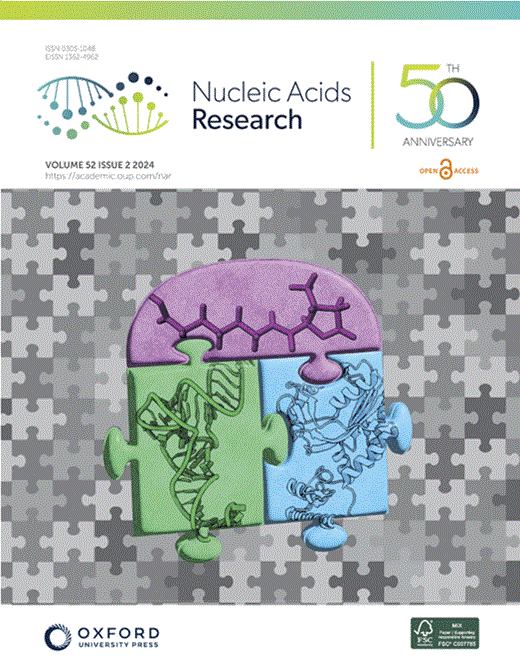GPATCH4在肝癌细胞中作为核仁r环的调节因子。
IF 16.6
2区 生物学
Q1 BIOCHEMISTRY & MOLECULAR BIOLOGY
引用次数: 0
摘要
新出现的证据表明,失调的rna结合蛋白(rbp)与多种癌症有关。然而,rbp在肝细胞癌(HCC)(肝癌最常见的亚型)发生中的确切作用和途径在很大程度上仍然未知。本研究通过多组学数据整合分析,系统搜索HCC中RBP候选物的改变,发现GPATCH4基因在约70%的HCC患者中扩增,其高表达预示着预后不良。我们通过iCLIP-seq绘制了GPATCH4在体内的RNA结合位点,并确定了GPATCH4主要结合核糖体RNA (rnas)。GPATCH4通过增加rRNA转录和全局蛋白合成,在体外和体内促进HCC细胞增殖和转化。GPATCH4主要定位于核仁,通过与DDX21的c端内在无序区相互作用,帮助解开rDNA上形成的RNA环。GPATCH4缺失诱导的累积r环的去除挽救了rRNA转录和细胞增殖的减少。综上所述,我们将未被研究的GPATCH4描述为HCC中具有致癌功能的RBP,并揭示了GPATCH4通过与DDX21相互作用作为核核r环的调节剂来控制rRNA转录的新机制。本文章由计算机程序翻译,如有差异,请以英文原文为准。
GPATCH4 functions as a regulator of nucleolar R-loops in hepatocellular carcinoma cells.
Emerging evidence suggests that dysregulated RNA-binding proteins (RBPs) are associated with a wide variety of cancers. However, the exact roles and pathways of RBPs in the tumorigenesis of hepatocellular carcinoma (HCC), the most common subtype of liver cancer, remain largely unknown. Here, we systematically searched for altered RBP candidates in HCC through multi-omics data integrative analyses and identified that GPATCH4 gene is amplified in >70% HCC patients and its high expression predicts poor prognosis. We mapped the in vivo RNA binding sites of GPATCH4 by iCLIP-seq and characterized that GPATCH4 primarily bound ribosomal RNA (rRNAs). GPATCH4 promoted HCC cell proliferation and transformation both in vitro and in vivo through increasing rRNA transcription and global protein synthesis. GPATCH4 is mainly localized in the nucleolus and helps to unwind RNA loops formed at the rDNA through interacting with DDX21 via its C-terminal intrinsically disordered region. Removal of accumulated R-loops induced by GPATCH4 depletion rescued decreased rRNA transcription and cell proliferation. Taken together, we characterized the understudied GPATCH4 as an RBP with oncogenic function in HCC and revealed a new mechanism by which GPATCH4 functions as a regulator of nucleolar R-loops to control rRNA transcription through interacting with DDX21.
求助全文
通过发布文献求助,成功后即可免费获取论文全文。
去求助
来源期刊

Nucleic Acids Research
生物-生化与分子生物学
CiteScore
27.10
自引率
4.70%
发文量
1057
审稿时长
2 months
期刊介绍:
Nucleic Acids Research (NAR) is a scientific journal that publishes research on various aspects of nucleic acids and proteins involved in nucleic acid metabolism and interactions. It covers areas such as chemistry and synthetic biology, computational biology, gene regulation, chromatin and epigenetics, genome integrity, repair and replication, genomics, molecular biology, nucleic acid enzymes, RNA, and structural biology. The journal also includes a Survey and Summary section for brief reviews. Additionally, each year, the first issue is dedicated to biological databases, and an issue in July focuses on web-based software resources for the biological community. Nucleic Acids Research is indexed by several services including Abstracts on Hygiene and Communicable Diseases, Animal Breeding Abstracts, Agricultural Engineering Abstracts, Agbiotech News and Information, BIOSIS Previews, CAB Abstracts, and EMBASE.
 求助内容:
求助内容: 应助结果提醒方式:
应助结果提醒方式:


